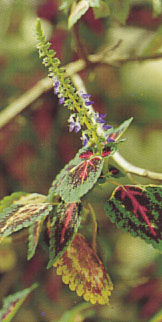
|
|
| Coleus blumei - Painted Nettle - Labiatae - Tropical and warm zones of Europe, Africa, Asia |
|
FAMILY: Lamiaceae (Mint Family) This annual plant is well known amongst horticulturists and amateur gardeners alike, it is a prized as an easy-to-grow houseplant and hardy outdoor ornamental; it produces many tiny beautiful flowers with colorful kaleidoscopic leaves. In the wild Coleus Blumei can grow up 3 feet (1 meter) tall, and about 1 foot (1/3 meter) around. The leaves are oval shaped with rounded tooth edges; most notability the leaves are brightly colored with green edges and blood-red veins in the center as well as many splotches of dark red, maroon, and brown. The flowers are very small and grow along a central stem, and they range from light mauve to violet in color. Coleus Blumei first originated in Southeast Asia and the Philippines, but was transplanted in the tropical regions of Mexico and has since become well known amongst the Mazatec Indians for its psychoactive properties. El Ahijado was first studied by Gordon Wasson while he was searching Southern Mexico for the mythical psychoactive plant used by the Aztecs, Pipiltzintzintli. During Wasson’s expedition through the Sierra Madre Mazateca region, not only did he discover the Indians ritual use of Salvia Divinorum as a hallucinogen, but he also learned of their use of Coleus Blumei as a potent substitute for Salvia. When Salvia Divinorum, La Hembra (the Woman) was unavailable, the native shaman would use the leaves and flowers of El Ahijado (the Godson) in its place. Very little is currently known about the active principle alkaloids in Coleus Blumei, there still needs to be much more research conducted on this plant and it potential uses. Fortunately, there has been a strong uptick in interest and there are more scientific studies underway. However, it is known that the plant contains Diterpene alkaloids and it is currently hypothesized that when Detripenes are dried and exposed to high temperatures its structure changes to resemble the active alkaloids present in Salvia Divinorum; though this is still supposition. TRADITIONAL USE: For centuries, the Mazatec Indians of southwestern Mexico have known and used El Ahijado in their religious healing ceremonies. In traditional Mazatec communities, Coleus Blumei is considered ‘the male’ (El Ahijado) and Salvia Divinorum is considered ‘the female’ (La Hembra). However, the shamen and healers tend to use Coleus Blumei only when they are unable to procure Salvia Divinorum. TRADITIONAL PREPARATION: The Mazatec natives tend to consume El Ahijado in two way, either as a fresh lea chewable quid or as a dried leaf smokable herb. Traditionally, eight to twelve small leaves are freshly picked from the plant, rolled into a quid and chewed, the juices are swallowed and after 15 – 20 minutes the used quid is discarded and exchanged for fresh leaves. In other Mazatec communities the leaves and flowers are gathers and dried, the resulting dried herbs are crushed and mixed with tobacco or Tagetes lucida (Mexican Tarragon) to be smoked. MEDICINAL USES: Traditionally, coleus Blumei has been used to treat many different common ailments. Most commonly, the Mazatec used this magical herb to treat stomach pains, digestive problems, dysentery, and even elephantiasis. In other parts of the world the plant was used to treat headaches, ulcers and used as a contraceptive to prevent pregnancy. TRADITIONAL EFFECTS: Many people report that small doses of El Ahijado are very similar to small doses of Salvia Divinorum, this is certainly a powerful Shamanic traveling plant and needs to be studied more carefully. Similar to many other plants like Salvia Divinorum and Cannabis Sativa, the effects of Coleus Blumei are not usually felt after the first trial, rather it take several attempts and knowledge of the plant to fully feel its inebriating effects. However, there is still much debate as to the efficacy and potentiality of Coleus Blumei, there are many reports from reputable ethnobotanists and ethnopharmacologists suggesting that they have experienced little to no effects with this plant… as is often the case, the journey is always viewed through the eye of previous experience. REFERENCES |
|
Related
Articles :
|
|
| Email
This Article To A Friend - Print
This Article Articles can be E-mailed to a friend and you can get a printable version of the article IMPORTANT: We provide all information for educational purposes only, and endorse or recommend nothing here. A special thanks to Keith for all his support and insight. |
|
